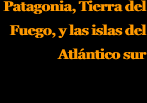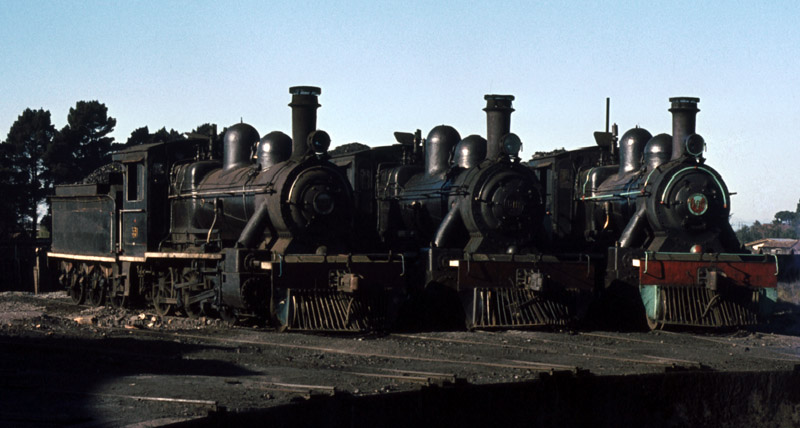 |
||||||||||||
 |
||||||||||||
 |
||||||||||||
 |
||||||||||||
Capítulo 5
La porción austral de la trocha ancha chilena
Guía al sitio
Páginas fundamentales
Construcción de la línea al sur •
Apéndices
3 Listas de máquinas a vapor chilenas •
4 Informe para PichiRopulli Osorno •
8 Fotos de estaciones vecinales 1 •
9 Fotos de estaciones vecinales 2 •
10 Reconocimiento a Lonquimay •
11 Acuerdo Barros Jarpa Noel •
13 Investigación para el túnel Lonquimay •
15 Especificaciones Técnicas *


Decline, closures and privatisation
During the 1960s and ’70s the familiar loss of traffic to the roads took place here as elsewhere. In an attempt to compete for passenger traffic the small batch of lightweight diesel railcars and trailers arrived from Ferrostaal O&K in Germany during 1970, but this was hardly enough to even postpone the inevitable.
Economic problems and political unrest during the Allende presidency in the early 1970s also affected the railways. In particular, track on the Valdivia line was dynamited in late October 1972, leading to the derailment of a train and serious injuries amongst the passengers (39).
General Pinochet’s military government seized power the following year, deregulated rural road passenger transport during the late 1970s, and in 1979 made the decision to remove all subsidies from the EFE. The inevitable consequence was the closure of almost all of the branches during the following five years, though a few remained mothballed for a while in case freight traffic should pick up again. The Riñihue metre gauge railway was closed first, in 1975, emphasising the point first seen in Chapter 4 that military governments, unbeholden to voters to keep them in power, find it easier to make unpopular decisions than their democratic counterparts.
Ostensibly dieselisation was proceeding steadily during this period, but in practice the southern end of the network continued to be largely steam-worked until the late ’70s, and even the supposedly diesel-hauled mainline passenger trains often reverted to steam when a diesel failed. The accompanying table shows the loco allocations at Osorno and Valdivia during 1977. Puerto Montt did not appear in this list and may merely have been a sub-shed of Osorno.
Three tipo 57 2-6-0s stand around the turntable at Victoria shed during April 1975.

However, mainline traffic continued to decline, and in 1990 daytime passenger services ceased to run south of Temuco. There remained a nightly service from Santiago with sleeping cars, saloons, diner, and car carriers, many of these facilities being removed for the part of the journey beyond Temuco. From 1996 this was in any case cut short to Puerto Varas owing to a landslide.
Eventually the service was cut back to a summer seasonal offering and on specific days rather than all. This suffered regularly from operating difficulties which caused huge inconvenience to the passengers, and so from the end of the 1997 summer season there was no longer a passenger service at all (40).
The EFE eventually decided to separate the rail freight business from the remaining passenger services and from the role of maintaining the infrastructure. Ferrocarril del Pacífico S.A. was created in 1993, and 51% of the shares were offered to the private sector during the following year. More recently, in 2003, control of FePaSA passed to the Sigdo Koppers group.
Further north, the business actively carries bulk loads of cellulose, steel, timber and wood chips, cement, agricultural produce and other cargoes, using around ninety locomotives and 3000 wagons. However, very little operates south of Temuco, as exemplified by the railway to Puerto Montt having been cut short at La Paloma on the outskirts of the city rather than operating down the steeply graded and winding route to the port as in the past. The Arauco cellulose factory at Mariquina seems to be the most southerly point from which regular freight is moved, only just within our area of interest, though the track south of there is reasonably well cared for.
Mainline passenger trains – a fresh start never fulfilled
Around 2004 the decision was made to invest in the reintroduction of regional passenger services along the full length of the mainline south of Victoria, connecting with the electric train service between Temuco and Santiago. This involved the refurbishment of some sixteen stations, with totally new facilities being constructed at the new La Paloma terminus on the northern edge of Puerto Montt. This then became known as ‘Puerto Montt’ in place of the old station on the quayside.
New stock was obtained for the service, in the shape of a batch of diesel twin units which had originally operated in Spain. The plan was to operate two trains daily in each direction with an increase to three each way when further stock became available.
The whole project involved the expenditure of some US$40M, and included the replacement of 108,000 sleepers and 3,000 tonnes of rail. However, despite an official opening by Presidente Lagos at La Paloma/Puerto Montt in December 2005, just two years of erratic operation passed before the scheme was abandoned! Currently there is not even a regular passenger service south of Chillán, much less beyond Temuco. The adjacent quote from a Chilean newspaper sums up the frustration felt by many in the region, though a visitor from abroad might well think it difficult to compete with what is now a high quality dual carriageway road all the way from Puerto Montt to the capital.
Nevertheless between 2009 and 2012 further work went on to upgrade the track all the way to Puerto Montt, with axle loadings of 25 tonnes for locos and 20 tonnes for wagons being catered for down to Osorno, and 20 and 18 tonnes respectively beyond that point, though the speed planned for at the southern end was only 50 kmph.
There has been discussion even more recently about the possibility of operating a tourist rail service, particularly for the cruise liners visiting Puerto Montt, north to Frutillar.
As mentioned, there are no regular passenger trains south of Chillán these days, but when in 2004 it was proposed that passenger services should return to the mainline between Puerto Montt and Victoria, four Spanish diesel sets were purchased for the new service, these being from the RENFE class 593, which had been three car units but now lost their central trailers. Others of this type now run in Argentina. In Spain they had been known as Los Camellos, from their distinctive air-conditioning ‘humps’.
Four reconditioned units, now entitled TLD or Tren Ligero Diesel, were readied for an inaugural run in December 2005, though that set off from Temuco rather than Victoria, covering the 376 km. in 6½ hours. The service began operating, and during 2006 there were further announcements about a service of a similar nature to Valdivia using two more TLD sets, but the whole scheme seems to have faded out sometime during the following year. There have been periodic campaigns to reintroduce such services, but given the frequent luxury coach services plying up and down the dual carriage-way all the way to Puerto Montt, any competing rail route would certainly struggle.
Operating procedures
The use of physical tokens has largely been superseded by radio communications and a series of protocols known as Autorización uso de Vía (AUV), by which the driver solicits and is eventually granted permission to enter a section by the traffic control centre. Similarly, cabooses or brake vans have largely been replaced by Dispositivos de Fin de Tren, the ubiquitous ‘smart’ ‘flashing rear-end devices’ known as FREDs in North America or BOGs (battery operated guards) in Australia.
The AUV system superseded the previous Reglamento General de Movilización in areas used exclusively by FePaSA. The principals do not greatly differ but the new procedures take account of the fact that the area south of Temuco now comprises 250 miles (400 km.) of railway largely without staff at fixed points. The role of Jefe de Tren, filled by the erstwhile fireman though to British eyes closer to the concept of the train’s guard, has thus to be more independent. Most recently a GPS location system has been integrated with the AUV routines.
Since abandonment a number of the branch trackbeds have become rutas verdes (green routes) for walkers and cyclists, usually using the original railway bridges and other structures. These include the eastern half of the Panguipulli branch and the lines from Crucero to Puyehue and to Lago Ranco.
References
23 Memoria anual del Director General de los FFCC del Estado, 1922, p178.
24 ArNAd volumes MOBR2211 and MOBR2569.
25 For example, see ArNAd volume MOBR2488 re the purchase of 60 cm. gauge locos.
26 ArNAd volume MOBR2211.
39 http://historiadevaldivia.blogspot.co.uk/2009/05/periodo-de-agitacion-social-y-politica.html
40 Pablo Moraga Feliú, 2010, Trenes en el sur, article in En Tren issue No. 17, pp3-7.
Photo credits
Credits are only listed here when the photographs have been provided by one specific archive or source. A large number of older photos come from postcards available in the public domain and from several different sources.
A Image by Señor Rodolfo Knittel Reinsch of Valdivia.
B Reproduced by kind permission of the Museo Histórico y Antropológico Maurice van de Maele, of the Universidad Austral de Chile, Isla Teja, Valdivia, Chile.
C Courtesy of the Centro Cultural ‘El Austral’, Casa Hoffmann, Calle Yungay 733, Valdivia.
D Photos taken by Trevor Rowe, reproduced by kind permission of the Restoration & Archiving Trust.
E Photos reproduced by kind permission of Osorno municipal library and archive.
F Photos originally published in the DOP annual memoria to Congress in 1930.
G Photos used by kind permission of Señor Nelson Beseler Avila.
H Photos by kind permission of Nick Slocombe.
I Photo taken for the EFE’s magazine En Viaje.
J Blueprint archived in ArNAd folder MOBR2325.
K Photo from the Osorno Décima Región de Los Lagos Facebook page.
L Photo by Carlos Beseler from Nelson Beseler’s collection.
M Ticket reproduced by kind permission of the Boleccionistas blog at http://boleccionistas-coleccionistas.blogspot.co.uk/2013/09/en-tren-de-ramal-en-ramal.html from the collection of Francisco Riquelme.
N Ticket image provided by courtesy of Señor Guillermo Yañez.
11-3-2018